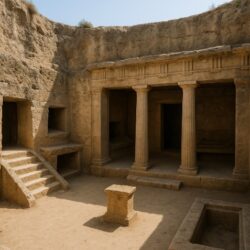A remarkable discovery has been made in Cappadocia, a historically rich region in central Turkey renowned for its unique landscapes and ancient heritage. A 3,000-year-old statue, dating back to the Hittite Empire, has been unearthed, offering valuable insights into the artistic, religious, and cultural practices of this powerful Bronze Age civilization.
The Hittite Civilization: Context of the Discovery
The Hittites were an ancient Anatolian people who thrived during the Late Bronze Age (circa 1600–1200 BCE). Their empire extended across much of Anatolia, with influence reaching the Levant and Mesopotamia. They were known for their monumental architecture, complex political systems, and advanced art, often focused on religion and royal symbolism.
Cappadocia, a pivotal region in Hittite history, served as a cultural and political hub during their dominance. The discovery of this statue not only highlights the region’s historical significance but also sheds light on the depth of the Hittite artistic and religious traditions.
Features of the Statue
1. Likely Representation
- The statue is thought to depict either:
- A deity, reflecting the Hittite’s polytheistic beliefs and ritualistic art.
- A ruler, emphasizing the Hittite tradition of commemorating kings and their divine authority.
- A mythological figure, consistent with their narratives intertwined with their religious worldview.
2. Artistic Craftsmanship
- Details: The statue showcases intricate carvings, including:
- Facial expressions, which convey emotion or divinity.
- Attire, possibly reflecting rank, status, or religious significance.
- Weaponry or symbols, hinting at its ceremonial or mythological context.
- Material and Technique: The craftsmanship reveals the Hittites’ advanced skills in stone carving, often combined with reliefs and symbolic motifs.
Significance of the Preservation
The statue’s relatively good condition after 3,000 years suggests it was shielded from environmental damage, likely stored in a cave, tomb, or temple. Its preservation is a testament to:
- Hittite Engineering: Their ability to create enduring works of art.
- Protective Environment: Cappadocia’s unique geology, with its volcanic rock formations, often served as natural shelters for artifacts.
Cultural and Religious Importance
1. Religious Practices
The Hittites were deeply religious, and their art often centered around their pantheon of gods and elaborate rituals. Statues like this were likely used in:
- Temples for worship.
- Ceremonies symbolizing divine favor or royal legitimacy.
- Funerary Practices, connecting the deceased with the divine realm.
2. Symbolism and Power
Such statues served as expressions of power, portraying rulers as intermediaries between the gods and their people or celebrating mythological stories central to the Hittite worldview.
Cappadocia: A Treasure Trove of History
1. A UNESCO World Heritage Site
Cappadocia’s landscape, characterized by fairy chimneys, rock-hewn churches, and underground cities, has long been a focal point of archaeological research.
2. Multicultural Layers
The region has been home to several civilizations, including the Phrygians, Romans, and Byzantines, each leaving a distinct mark on its history. The discovery of this statue adds to its rich narrative, cementing Cappadocia’s importance in understanding ancient Anatolian cultures.
Future Research and Implications
1. Ongoing Studies
- Archaeological Analysis: Researchers will focus on the statue’s stylistic elements, material composition, and context of discovery.
- Cultural Insights: Study of the statue’s attire, symbols, and craftsmanship will offer clues about Hittite beliefs, societal norms, and their interactions with neighboring cultures.
2. Broader Significance
The statue enhances our understanding of:
- Hittite Religion: How gods, myths, and rituals were visually represented.
- Artistic Traditions: The evolution of Hittite stone carving and symbolism.
- Societal Structure: The roles of deities and rulers in reinforcing power dynamics.

Key Takeaways
- The discovery of this 3,000-year-old Hittite statue represents a major archaeological breakthrough, illuminating the artistry and beliefs of an ancient civilization.
- Cappadocia, already renowned for its geological wonders and historical richness, further solidifies its status as a key site for understanding Anatolia’s ancient past.
- Continued research on this artifact will provide invaluable insights into the Hittites’ worldview and their remarkable achievements in art and culture.
This discovery not only enriches our knowledge of the Hittite Empire but also serves as a reminder of the enduring legacies left by ancient civilizations in shaping human history.












